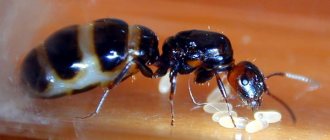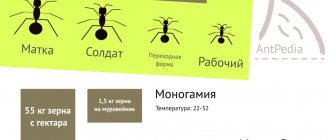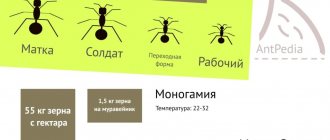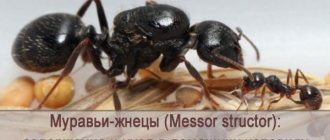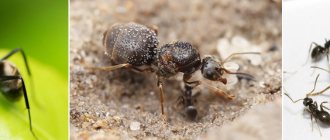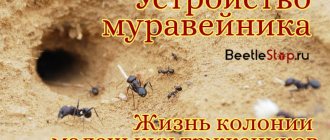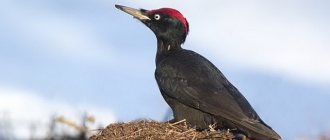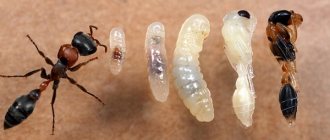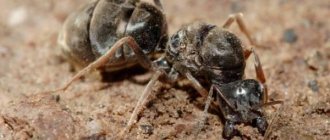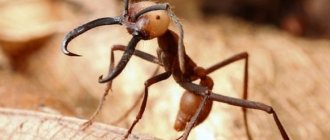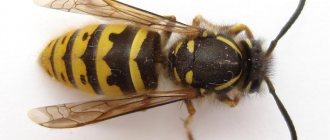Ants are colonial animals with a strict colony organization that varies among species. A colony usually consists of one or more egg-laying individuals - queens - and workers. In some species, workers can be divided into castes - small, medium, large workers and soldiers. This polymorphism of workers is characteristic, for example, of reapers.
The life cycle of ants begins with an egg laid by the queen. It has a spherical shape; Usually the eggs stick together to form a “package” and are carried in this form by workers. After a few days, the egg hatches into a larva. By themselves, the reaper larvae are not able to move or feed independently and have a cone-shaped shape with a curved upper part. The workers feed the larvae. In the case of harvester ants, the main food is flour obtained by grinding plant seeds. As the larva grows, it increases significantly in size and, depending on conditions, pupates in 1-2 months. Reaper pupae do not have cocoons, so you can follow how the metamorphosis into a full-fledged ant occurs. At the last stage of development, the pupae darken and begin to move.
Appearance of harvester ants and their habitat
The body of insects consists of three parts - the head, thorax and abdomen. They are connected to each other by movable jumpers, which makes the reapers very flexible. There are three pairs of limbs on the chest. The large head has powerful jaws - mandibles, which are convenient for carrying food and grinding seeds and grains. The color of the ants is dark, reddish-brown. Their length is considered one of the largest among other families of ants: worker ants have a length of 4 to 9 mm, while the queen reaches truly enormous sizes - from 11 to 15 mm.
The steppe ant differs from other representatives of the ant family by its characteristic reddish-orange color
Harvester ants live in steppes, semi-deserts and deserts in Asia, North and South Africa and America.
Keeping ants: two basic rules
To keep ants, the future owner needs to take into account two basic rules:
Nutrition
It is recommended to feed ants food rich in carbohydrates. Pumpkin seeds, boiled potatoes or sunflowers are suitable. Plain water or a few drops of sweet syrup will do as a drink.
Cleaning
Ants periodically mark the formicarium with a special secretion. Often such marks spoil the overall appearance of the farm and do not allow insects to be observed. Your task is to carefully remove part of the secretion using cotton swabs or pads.
How is an anthill organized?
Up to 5 thousand individuals can live in an anthill.
There is a strict hierarchy in the colony of harvester ants: each family member is busy with his own business. The family consists of a queen - she produces offspring, soldiers - they protect the anthill from dangers and help with harvesting, worker ants - they are engaged in obtaining food and caring for the young. There are also males and females - they mate with each other, creating new colonies.
From the outside, the anthill's shape resembles a volcano
The ground part of the ants' home is a hole in the soil, along the edges of which there is a shaft of earth and debris from the prey they bring. The underground part has a vertical tunnel, from which passages with cameras extend on the sides. In these rooms, ants set up pantries for storing food and “children’s rooms” in which they store larvae.
Dangers when breeding ants
The first danger to the life of insects is your impatience. Do not rush to move the ants to a new home. This usually takes at least three days. You cannot shake off the uterus. If it falls, it can be damaged and die, and the death of the queen means the death of the entire colony.
The second danger is experimenting with food. Don't give ants anything you doubt. If you are not sure whether, for example, gingerbread or sausage can be eaten by insects, it is better to refuse such food.
The third mistake when breeding ants is the lack of information about their life. Before you buy an ant farm, learn as much as you can about breeding and caring for ants so as not to be disappointed and not destroy them.
Flood and drought pose a great danger to insects. There are situations when water from the drinking bowl gets into the living compartment, and cases when the cotton swab was chewed by ants or was not dense enough, as well as when the sponge is of the wrong size. If you notice an accumulation of water in a residential area, immediately provide the ants with the opportunity to leave this part of the farm and move to a dry area. They also require relocating insects to another formicarium when the seeds for feeding begin to germinate or when black mold appears on the walls.
What do harvester ants eat?
Particular attention should be paid to the feeding and extraction of food by the reapers. Since they most often feed on grain crops, ants were long thought to be agricultural pests. However, research has shown that insects only harvest crops that directly fall to the ground.
Reserves
The gathering of provisions is very interesting among the reapers. As stated earlier, the harvesting of grain occurs when it is on the ground.
The workforce collects about 1.5 kg of grain crops from the fields in one season
Scientists have found that harvester ants send out workers as much as there is available food. If there is a lot of it, then the workers return faster and the number of ants sent for food increases. But if they return slowly, then the number of ants sent out decreases or stops altogether.
To store grain, hardworking reapers set up special rooms deep underground. In damp, warm rooms, the seeds begin to germinate, and as soon as the first sprouts and roots appear, the ants immediately destroy the shoots. After this, large soldier ants grind the grain into powder with their powerful jaws and, moistening it with saliva, feed this mixture to the larvae.
Ant farm cleaning
Ants put their garbage in a certain place. You can install a “trash can” in this place, which can then be easily shaken out. There is a way to train insects so that they put all their garbage in a special container. The thing is that ants mark their territory with a special secret. Using the smell that depletes this secretion, they determine the location of various objects on the farm. The place where they plan to create a garbage dump is marked with particular intensity. After the insects have marked their territory, you will need to place some kind of lid or jar in the place where they begin to pile up garbage. The ants will first sweep it and begin to put their garbage in it. The most important thing when cleaning is not to wash off this secret, which they use to mark garbage containers. In the future, if you want to change the insect farm and move them to a new place, you immediately install the container from the old farm in a place convenient for you.
Reproduction and lifespan of harvester ants
There is one queen in each ant nest. Mating occurs in early spring in April, as the reapers settle in the steppes with a warm climate. After fertilization of the uterus, the male dies, and the female goes to look for a suitable place to found a new colony. A full-fledged workforce appears by the end of summer.
The development cycle of ants is complete: egg - larva - pupa - adult
The first three stages take place in 2–3 weeks each. Reapers reproduce in two ways - sexual and asexual. At the first stage, males and females are born, which are needed for further reproduction. Asexual reproduction is called parthenogenesis, that is, the female reproductive cell develops into an adult organism without fertilization by a male. With such reproduction, only worker ants are born.
Larval development
After fertilization, after some time, the uterus lays eggs. After this, they are moved to separate chambers and ensure that favorable conditions are maintained. The division into worker castes occurs already at the moment the larvae hatch from the eggs. Which caste the future individual will belong to depends on how much food the larva consumes.
The well-being of future worker ants is ensured by breadwinners and caregivers
The young generation is constantly growing and pupates in 1–2 months. The pupa has a thin shell, which allows you to monitor the development of the insect. At the last stage, a full-fledged ant appears, which lives from one to five years.
What is this
An ant formicarium is an anthill made by human hands.
The first man-made anthills were built by scientists back in the 19th century for scientific observations. Over time, thanks to popular naturalists, the social behavior of ants became of interest to people far from science, and as a result, the simplest designs of home anthills began to appear.
Did you know? The famous French writer Bernard Verber wrote three science fiction novels about ants in 1991-1995: “Ants”, “Day of the Ant”, “Revolution of the Ants”, which are still bestsellers.
The first formicarium was patented in 1931 by Frank Austin , a research professor at the Thayer School of Engineering at Dartmouth College. Since then, ant farms have been sold all over the world and even sent cash on delivery, such as Uncle Milton's Ant Farm. About 20,000,000 educational “toys” under this brand have been sold.
How to keep harvester ants at home
Nowadays, many people, as a hobby, start so-called ant farms, which are transparent boxes made of plastic or glass. Inside them there is an imitation of an anthill - numerous passages and chambers.
Thanks to the transparency of the walls, it is possible to study the life of insects in detail.
Purchasing an anthill - what kinds of anthills there are, their cost
A home anthill, or formicarium, looks like an aquarium or a display case with filler inside. There are simple and complex systems in which a climate favorable for the life and reproduction of ants is automatically created and maintained: lighting, humidity and temperature. There are different sizes - from small tabletop farms to bulky anthills for the living room or office. Various fillers are used for formicaria: gel, gypsum or a mixture of soil and sand.
The so-called “Cubus” and “Colosseum” models are shaped like a cylinder, cube or double-walled display. The space between them is filled with multi-colored sand, in which the ant colony builds passages and chambers. The cost of such structures is high - from 3 thousand rubles, but the kits include food for ants, sand and other additions.
Formicarium brand "Colosseum"
An anthill with a gel filler is similar to an aquarium, but is filled not with water, but with a transparent gel. Such a house for reapers does not require careful maintenance, but once every 5–7 days the lid of the aquarium must be opened for a couple of minutes for ventilation. The price of such formicariums is low - from 500 rubles.
This filler is safe for people and insects - it is both a habitat and a breeding ground for ants
A plaster truss is affordable in price (from 700 rubles). This is the most popular type of domestic anthill. The surface of the gypsum is often painted in bright colors, which makes formicariums a stylish and unusual addition to any interior.
The plaster model is perfect for children and beginners in ant breeding.
Ant houses can be purchased in specialized online stores. The catalogs contain farms of various models and sizes. As a rule, pet stores do not sell ant farms.
Making a formicarium yourself
If you are not attracted by prices in stores, then there is the opportunity to make a formicarium with your own hands. For the base, you can take two jars with transparent walls - a large and a small one - and then fill the space between them with the selected material. It can be a mixture of soil and sand, gypsum or gel.
Choose a large jar with a wide mouth to make it easier to fit smaller jars.
Soil-sand farm
To begin, prepare a mixture of one part sand and two parts soil. Make sure that the composition is slightly damp - it will be easier for ants to break through passages and chambers. The mixture will be needed so much that the space between the jars is filled 1.5 cm from the edge of the vessels. Make small holes in the lid for air circulation.
Gel farm
Making such a farm yourself will be interesting for both adults and children. To do this, you will need gelatin and a flat container with a lid and transparent walls.
Pour three 15 gram bags of gelatin into 0.5 liters of hot water and stir well until the gelatin dissolves. Then add another 0.5 liters of water. Cool the resulting composition, pour into a container of your choice and place in the refrigerator until completely solidified. Then remove the container and wait for the mass to warm to room temperature. Since the gel composition is also food, there is no need to feed the ants in such an anthill - they will get the necessary food from their house.
Gypsum farm
This formicarium is attractive because it is completely open for observation by ants.
To create an anthill, take a transparent container, then dilute the plaster to a thick cream. Pour the composition into a transparent plastic container, placing a plastic straw at the side. This is necessary in order to then add water to the plaster to maintain humidity in the formicarium.
The workpiece dries completely in about a week. After three to four days after pouring, remove it from the mold. To make the plaster come out easily, immerse it in hot (not boiling water) water for thirty seconds.
Now show your creativity - draw passages and rooms on the plaster. The composition is still raw, so it will not be difficult for you to scratch out any tunnels.
Drill an entrance for future residents of the farm using a drill. Take any tool convenient for you (a stationery knife, screwdriver, etc.) and start making paths according to your design, choosing plaster from them. Proceed with caution so that the wet mixture does not crumble.
Make indentations at the bottom of the formicarium to better distribute water and moisturize the anthill. Don't forget about the ventilation holes in the container. Drill them with a drill (0.5 mm diameter) in the lid and side walls.
After this, you need to thoroughly dry the gypsum base and place it back into the container. If it does not fit, soak the mold in hot water again for 30 seconds. Your anthill is ready to move in.
Ant food
The main thing when caring for ants is to avoid fuss, as these insects are very shy and can behave inappropriately, feeling stress and discomfort. Before breeding ants, you need to study the rules of their behavior within the family and the laws by which they live. After you bring the queen home in the first days, you should not feed her. Nature has laid down a mechanism in which she will have enough nutrients by the time she has time to breed working individuals who will then feed her. However, if you cannot resist feeding, you can give one drop of sugar syrup the size of an insect's head.
Please note that reapers are not given syrup. They are fed grains. For the queen to hatch eggs successfully, she should not be disturbed or create stressful situations. This may cause the queen to destroy all the brood. When laying eggs, she should create the most comfortable conditions possible. After the first working insects hatch in your formicarium, you can start feeding the ants more often. To do this, special seeds purchased from pet stores are poured into the feeder.
For the mother, drops of syrup are left on foil, which are removed after a few hours so that they do not have time to ferment or thicken. If you want your ants to grow faster, feed them protein foods. Such food can be shrimp, chicken fillet or boiled egg white. It is not recommended to give ants live insects, especially large ones. This can be stressful and frightening. There are also situations when ants cannot cope with a large insect, and it kills them. You should not forget about foods that contain carbohydrates. Adult ants especially need it. Carbohydrates are found in seeds, sweet syrups, vegetables and fruits. Reapers especially need such food. If you are in doubt about the correct diet for your ants, consult with store clerks or online forums.
The food portion increases over time as the colony grows. If the colony is small, feed food in small portions. Eliminate salt and spices from your diet. To protect goosebumps from poisoning and death, heat-treat protein products. To do this, dip the pieces of meat in boiling water for a few minutes. Do not leave such food for a long time so that it does not have time to spoil and smell.
Poppy seeds are used unfried, without any additives. You can also use pumpkin seeds, canary food, zucchini seeds, sunflowers, sesame seeds, dandelion seeds, you can give boiled potatoes, all vegetables and fruits raw without nitrates. The rate of colony development depends on the quantity and quality of protein food, since protein is necessary for the formation of egg shells and chitin of adult insects. Insects are fed: flies, cockroaches, garden crickets, spiders and others. Protein should be given to goosebumps once a week in different forms. Calculate the amount of food so that the ants can eat it at one time.
War with uninvited "guests"
When you see the first scouts darting around the kitchen in search of provisions, immediately begin to think about a military strategy. Do not forget that these pests are capable of multiplying very quickly, and in just a month or two they can occupy your apartment.
Destroying a nest
No matter how much you crush the ants running around the table, or spray poison on them, their ranks will constantly replenish. After all, the queen continues to lay eggs. To get rid of insects, it is necessary to destroy the females. And to do this you need to find a nest of ants in the apartment. Searching for a colony is a very difficult task that does not always give a positive result. But try it anyway. To make it easier to find the nest, consider the following features of anthills.
- Warm place. Most ants like a warm, moist environment. So start looking for a colony in the kitchen or bathroom.
- Hard to reach areas. The nest may be located under tiles, in sockets. And sometimes anthills are located even outside the apartment, for example, between floors, in ceilings. In this case, it is impossible to find the nest.
- Surveillance. To determine the location of a colony, you simply need to follow a line of insects. They will lead you to the nest.
Preparation for processing
Don't despair if you can't find the nest. You can destroy the female without even touching the colony. This is not difficult to do. It is necessary to force the soldiers to take poisonous substances in order to take them to the nest as food. Many folk traps and insecticides are built on this principle. Don't forget to prepare thoroughly for the fight.
- Wash surfaces. Wipe all countertops and tables with a damp cloth, removing crumbs, food debris, sugar, and rinse the floors with vinegar and Domestos to destroy the paved paths and disinfect the apartment from ants.
- Remove food and trash. Hide baked goods and cookies in plastic bags, carefully close the trash can with a lid, or better yet, take it out of the apartment altogether.
- Inspect the plumbing and baseboards. Fix the faucets, repair the water pipes so that the house does not have dripping water necessary for insects, identify any cracks and seal them with caulk.
Safety regulations
Chemical insecticides and even some folk remedies can be dangerous not only for insects, but also for animals and people. Therefore, before you start killing food ants, be sure to take safety precautions.
- Isolation of residents. To protect children, elderly relatives or pets from possible intoxication while fighting ants, place them with friends or relatives.
- Means of protection . Wear gloves. If the drug has an odor, wear a respirator. In the case of insecticides, try to protect your body, limbs and head as much as possible from getting chemicals on your skin. Take care to protect your eyes as well.
- Disposable tableware . Do not use food plates to prepare solutions or powders, even if we are talking about folk remedies. It is not safe. Buy disposable tableware, which you immediately throw away after baiting insects.
Edible bait recipes
Sometimes repellent scents are not enough to get rid of insects. In this case, influence the pests not only with the smell, but also with the prepared poison.
Yeast balls
Peculiarities . To get rid of pests, you can prepare small yeast balls. This mixture is ingested by insects. Due to the yeast, it gradually swells, which leads to the death of the parasites.
- sugar - 40 g;
- yeast - 35 g;
- water - 30 ml.
- Mix sugar with water.
- Add yeast to thick syrup.
- Stir the mixture until you get a paste-like mixture.
- Roll several small balls.
- Place them around the house.
Essential Oil Blend
Peculiarities . If you need to get rid of black ants in your apartment, then feel free to use any strong scents. These pests cannot tolerate garlic, mint, or lemon. You can drop a few drops of citrus oils onto a napkin and leave it in the kitchen. To enhance the effect, use a more effective recipe that will get rid of not only black insects, but also red, yellow and red ones.
- ethyl alcohol - 250 ml;
- lavender oil - ten drops;
- peppermint oil - 20 drops;
- water.
- Combine alcohol with essential oils.
- Dilute the resulting mixture with cold water to obtain a half-liter solution.
- Pour the product into a spray bottle.
- Irrigate all ant paths daily with a fragrant solution, shaking before use.
Sugar-soda poison
Peculiarities . When deciding to get rid of ants in the kitchen, consider an option that combines baking soda and sugar. This drug does not work instantly. The sugar-soda poison captured by the soldiers is brought to the nest as food for the inhabitants of the colony. The acid in the body of insects reacts with soda, causing their death.
- baking soda - one tablespoon;
- powdered sugar - one tablespoon.
- Mix the baking soda and sugar thoroughly.
- Pour the resulting powder onto plates or paper.
- Place bait throughout the kitchen.
Semolina mixture
Peculiarities . Semolina works on the same principle as yeast. After entering the body of an ant, it gradually swells, causing the death of the latter.
- semolina - one tablespoon;
- jam - one tablespoon.
- Mix the ingredients.
- Roll into small balls.
- Place them around the perimeter of the room.
Boric acid
Peculiarities . White crystalline powder remains the leader in the fight against ants to this day. However, if ingested, boric acid can cause severe intoxication in humans. Strictly adhere to the recommended proportions. This will protect you from the consequences and allow the ant to carry the poison into the colony. Otherwise, you will only destroy the soldiers.
- egg yolk - three pieces;
- boric acid (powder) - half a packet;
- honey - two tablespoons.
- Mash the boiled yolks.
- Add boric acid.
- Mix with honey.
- Roll small balls and place them around the kitchen.
Destructive starch
Peculiarities . The effect of starch on the ant's body is completely similar to boric acid. But, unlike the latter, starch does not cause intoxication of the body in people or pets.
- Make special baits by dropping a little honey or jam into the center.
- Surround the treat with starch on all sides so that insects cannot get past it.
